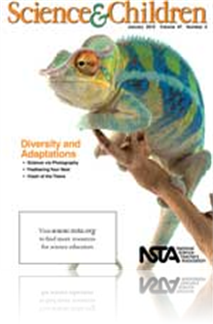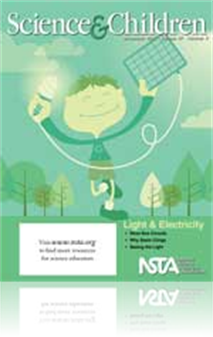All Science and Children resources
Journal Article
Methods and Strategies: Inventive Learning Stations
Learning stations can be used for myriad purposes—to teach concepts, integrate subject matter, build interest, and allow for inquiry—the possibilities are limited only by the imagination of the teacher and the supplies available. In this article,...
Journal Article
Science 101: What’s behind the biological classification system in use today?
Whether students should memorize classification schemes (taxonomies) is a column in itself, but the author can address the role that this system plays in the study of biology. To that end, it will help to address how the system developed over time. A...
Journal Article
How to Make a Plant Field Guide
Every year, an elementary school celebrates different aspects of Central Texas ecology. This year, they focused on Blackland Prairie, the ecoregion on which the school is located. A schoolwide event at the end of the year offers students the opportu...
Journal Article
The Early Years: If You Were a Dinosaur…
Dinosaurs are one of those science topics that draw children in and teach them about concepts like measuring and using descriptive language. Learning about dinosaurs, although not hands-on like observing and recording caterpillar growth, develops cri...
Journal Article
Editor’s Note: Approaching Adaptation
As students approach adaptations lessons, keep in mind that according to research, most lower-elementary school students are still forming a basic understanding of how animals survive in their environments. For example, many students understand a sim...
Journal Article
Children are naturally curious about the world in which they live. To focus this sense of wonder, have your students investigate their local habitat as it changes over the year. This multiseason study will build connections and add relevance to the h...
Journal Article
In “The Magic Mirror” lessons described here, children explore reflection and mirror phenomena in the environment. They make a mirror, explore a hinged mirror with its many images, and look at symmetries. The activities create great interest amon...
Journal Article
Teaching Through Trade Books: Flick a Switch
When students flick on lights, boot up a computer, or turn on a television, do they think about how that energy is produced? The majority of electricity in the United States is generated from power plants that burn fossil fuels, causing large amounts...
Journal Article
The Pennies-as-Electrons Analogy
Everyday experiences familiarize students with the ways in which electricity is used, but often the underlying concepts remain a mystery. Teachers often use analogies to help students relate the flow of electrons to other common systems, but many tim...
Journal Article
Using Wiggins and McTighe’s (1998) concept of Big Ideas, the authors planned and designed an electricity investigation to address common student misconceptions about static electricity. With Styrofoam plates and transparent tape, elementary student...
Journal Article
Every Day Science: December 2009
This monthly feature contains facts and challenges for the science explorer....
Journal Article
On a partly sunny afternoon, a fourth-grade class at the Marietta Center for Advanced Academics in Marietta, Georgia, was gearing up to explore key concepts regarding the nature of light. Armed with translucent beads and white pipe cleaners, the clas...
Journal Article
Editor’s Note: Seeing in the Dark
It seems like such a simple concept, seeing an object; light leaves its source, is reflected off an object, and travels into our eyes. Without light, we cannot see. Light and electricity may seem to be simple concepts, but don’t be fooled. Assess s...
Journal Article
Conceptually, students are typically introduced to light as a type of wave. However, children struggle to understand this model because it is highly abstract. Light can be represented more concretely using the photon model. According to this scientif...



